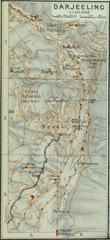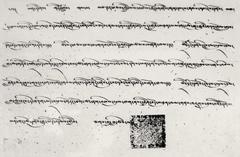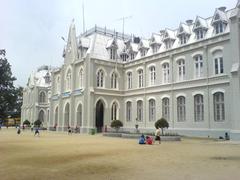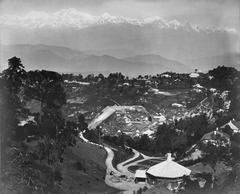
Ghum Railway Station Visiting Hours, Tickets, and Travel Guide in Darjeeling
Date: 04/07/2025
Introduction
Perched at a breathtaking altitude of 2,258 meters (7,407 feet), Ghum Railway Station stands as India’s highest railway station and an enduring symbol of the Darjeeling Himalayan Railway’s (DHR) engineering brilliance. More than a mere transit point, Ghum is a living heritage site that weaves together colonial history, multicultural traditions, and the awe-inspiring vistas of the Eastern Himalayas. Since its establishment in the late 19th century, Ghum has connected the plains of West Bengal with Darjeeling’s vibrant hill station, fostering trade, migration, and cultural exchange.
This comprehensive guide details everything you need to know about visiting Ghum Railway Station: from its historical and cultural significance, ticketing procedures, and visiting hours, to travel tips, accessibility, and nearby attractions. Whether you are a railway heritage enthusiast, cultural explorer, or scenic traveler, this resource will help you plan a memorable visit to one of India’s most unique destinations. (Odyssey Traveller, Darjeeling Tourism, trainstation.world)
Table of Contents
- Introduction
- Historical and Cultural Significance
- Engineering Innovations: The DHR and Ghum
- Visiting Ghum Railway Station
- Nearby Attractions
- Special Events and Heritage Tours
- FAQs
- Visual & Practical Tips
- References
Historical and Cultural Significance
Ghum Railway Station opened in 1881 as part of the Darjeeling Himalayan Railway—a narrow-gauge marvel that overcame Himalayan gradients with ingenious loops and zigzags. The DHR, designated a UNESCO World Heritage Site in 1999, exemplifies 19th-century colonial engineering and has played a decisive role in making Darjeeling a cosmopolitan hill station. Ghum Station itself became a crucial hub for trade, migration, and the transport of Darjeeling tea, while also acting as a bridge between Nepali, Tibetan, Bengali, and British influences.
The presence of the DHR Ghum Museum within the station premises preserves this legacy, showcasing vintage locomotives, original railway equipment, and archival photographs. Ghum’s cultural importance is further celebrated through community events and the continued operation of heritage steam locomotives, such as the iconic “Red Panda” service and the legendary 782B engine—recently commemorated for 125 years of service (newkerala.com).
Engineering Innovations: The DHR and Ghum
- Narrow Gauge Design: The DHR’s 2-foot (610 mm) narrow-gauge track enables sharp curves and steep ascents through the Himalayas, a feat unmatched by standard gauge railways (Odyssey Traveller).
- Loops and Zig Zags: Ghum is situated after the famous Batasia Loop, which helps trains gain altitude and offers panoramic views of Kanchenjunga.
- Heritage Locomotives: Both steam and diesel engines operate on the line, preserving the railway’s historical character (trainstation.world).
Visiting Ghum Railway Station
Visiting Hours
- Station and Platforms: Open daily from 9:00 AM to 5:00 PM (seasonal variations possible).
- Ghum Railway Museum: Typically open from 10:00 AM to 4:00 PM.
It’s best to confirm timings in advance, especially during holidays or for special events.
Ticket Booking and Prices
- Toy Train Joy Ride Tickets: Book online via the IRCTC website or at Darjeeling/Ghum stations. Advance booking is highly recommended during peak seasons (March–May, October–December).
- Ticket Prices: Round-trip fares between Darjeeling and Ghum usually range from INR 150–300 (standard class) and up to INR 1,500 for first-class or steam engine rides. Museum entry is often included with train tickets.
- On-the-spot purchases: Limited tickets may be available at the station, but are not guaranteed during busy periods.
Accessibility
- The station has steps, uneven surfaces, and limited facilities for differently-abled visitors due to its heritage structure. Assistance can be requested from railway staff.
- No dedicated lifts or ramps as of 2024; visitors with mobility needs are advised to contact the station in advance.
How to Reach Ghum
- From Darjeeling: 6 km by shared jeep, taxi, or Toy Train (25–45 minutes).
- From New Jalpaiguri (NJP): 80 km by road or scenic Toy Train ride.
- From Bagdogra Airport: 62 km by taxi or shared cab (2.5–3 hours).
Best Time to Visit
- Spring (March–May): Pleasant weather and clear mountain views.
- Autumn (October–November): Crisp air, vibrant festivals, and scenic clarity.
- Morning rides: Offer the best visibility and fewer crowds.
Nearby Attractions
- Batasia Loop: A spiral railway track and landscaped garden with panoramic Himalayan views and the Gorkha War Memorial.
- Yiga Choeling Monastery (Old Ghum Monastery): Established in 1850, features a 15-foot Maitreya Buddha statue.
- DHR Ghum Museum: Railway memorabilia and exhibits on the history and social impact of the DHR (darjeeling.travel).
- Darjeeling Tea Gardens: Nearby plantations and tasting tours.
- Tiger Hill: Famed for sunrise views over Kanchenjunga.
Special Events and Heritage Tours
- Heritage Train Rides: Seasonal steam-hauled services and themed journeys.
- Anniversary Celebrations: Community events, folk dances, and music mark special milestones, such as the 125th anniversary of locomotive 782B (newkerala.com).
- Guided Tours: Available via local tourism offices and the DHR Ghum Museum.
FAQs
Q: What are the visiting hours of Ghum Railway Station and the museum?
A: Both are open from 9:00 AM to 5:00 PM (museum: 10:00 AM to 4:00 PM); confirm before visiting.
Q: How can I buy Toy Train tickets?
A: Book online via the IRCTC website or in person at Darjeeling/NJP stations.
Q: Is the station accessible for differently-abled visitors?
A: Accessibility is limited; assistance is available on request.
Q: What’s the best time for a visit?
A: March–May and October–November for pleasant weather and clear views.
Q: Are guided tours available?
A: Yes, through the DHR Ghum Museum and local operators.
Visual & Practical Tips
- Photography: The Batasia Loop and station exteriors are perfect for photos—carry extra batteries and storage.
- Clothing: Layered, warm attire is recommended due to Ghum’s elevation.
- Local Markets: Sample local tea and snacks; support artisans by purchasing handicrafts.
- Sustainability: Carry reusable water bottles and avoid single-use plastics.
- Emergency Contacts: Railway Customer Care: 139; Darjeeling Police: +91-354-225-4321; District Hospital: +91-354-225-2951.
References
- Odyssey Traveller: Darjeeling Himalayan Railway
- Darjeeling Tourism: Ghoom Station & Museum
- trainstation.world: Toy Train Station Darjeeling
- IRCTC Darjeeling Joy Ride Guide
- Ease India Trip: Toy Train Guide
- Darjeeling Travel: DHR Ghum Museum
- New Kerala: 125 Years Steam Locomotive 782B
Plan Your Visit
Ghum Railway Station is more than a transport hub; it is a living monument to Darjeeling’s past, present, and future. Experience the nostalgia of the Toy Train, the serenity of Buddhist monasteries, and the warmth of local culture. Book your tickets early, dress for the mountain climate, and embrace the adventure.
Download the Audiala app for current travel guides, ticket bookings, and insider tips. Follow us on social media for the latest updates and special offers. Start your journey to Ghum—the highest point of India’s railway legacy—today!





